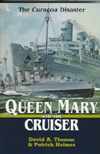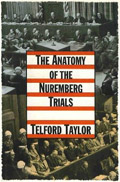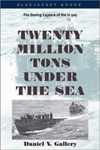Queen Mary and the Cruiser
The Curacoa Disaster
Thomas, David A. and Patrick Holmes
1997, United States Naval Inst.
ISBN 1557506981
Hardcover, 208 pages, 30 b&w photos, 6 tables, 2 sketches, 1 diagram, 7 appendices
| Type. | General History |
| Pros. | Corrects many longstanding errors |
| Cons. | None to speak of |
| Rating. |  |
 On 2 October, 1942, the Queen Mary, carrying over 10,000 U.S. troops across the Atlantic, ran over her escort, the cruiser Curacoa, slicing the latter in half with great loss of life. This book attempts to set the record straight on the exact sequence of events that led to this disaster.
On 2 October, 1942, the Queen Mary, carrying over 10,000 U.S. troops across the Atlantic, ran over her escort, the cruiser Curacoa, slicing the latter in half with great loss of life. This book attempts to set the record straight on the exact sequence of events that led to this disaster.
338 men on the Curacoa lost their lives, including all officers with the exception of the captain and Temporary Sub-Lieutenant Patrick Holmes, RNVR. Holmes was an active co-author in this book which seeks to correct many misconceptions about the case. First, there is the issue of the cruiser's name, which is commonly misspelled Curacao to match the name of the Caribbean island. Other reports wrongly recorded that the weather was stormy (it was clear, although the seas were high); placed the occurrence on a different date; gave the number of U.S. troops on board the Queen Mary as 15,000 when it was in fact somewhat lower; mistook the position of the sinking; and misreported the number of survivors. Finally, the most enduring myth, that Curacoa swerved in pursuit of a U-boat, is refuted; the authors rightly point out that no U-boat was sighted from either vessel (see below for further details on this point). Curacoa fatally crossed paths with Queen Mary for quite another reason.
The first half of the book sets the scene, detailing the history of the Curacoa and her namesakes before her; the career of her captain and of the captain of the Queen Mary; and the history of the Cunard liners. The second half of the book describes the tragedy itself, the later testimony of witnesses from both vessels, an analysis of the transcripts from an Admiralty trial whose purpose was to determine negligence in the case, and the course of an appeal to the judgment given some months later. In both court cases, the Curacoa was found to carry the full blame for the accident. However, the authors make crystal clear the key issue: both captains held the fixed opinion that the other vessel should give way. Misunderstandings and lack of communication were the true causes of the tragedy.
One of the most significant contributions of this book is that it finally lays to rest the myth that U-407 was involved in the collision. Perpetuated most recently by Blair in Hitler's U-boat War, Volume II, the commonly related story is that U-407 fired a fan of torpedoes at Queen Mary (all of which missed), and was sighted by Curacoa, which abruptly changed course into the path of the liner to attack the U-boat. The authors point out that no one on either ship reporting having seen a U-boat or torpedo tracks, and on this basis, along with an analysis of the sequence of orders that led to the fatal crossing of paths of the two vessels, they conclude that no U-boat was present during the sinking of Curacoa.
As a look at the logbooks will show us, the authors are quite right on this point. The true movements of U-407 in relation to Queen Mary are as follows:
- (1) On 1 October at 0813hrs, U-407 fired a four-torpedo fan on Queen Mary in grid BD 33, at approximately 50N 26W. All torpedoes missed.
(2) On 2 October at 1312hrs, Curacoa sank at approximately 55-50N 08-38W. The distance between the coordinates in point 1 and point 2 is some 650 miles, which the Queen Mary easily covered in the intervening hours, but which would be impossible for a U-boat even at sustained top speed.
(3) On 2 October, U-407 fired two torpedoes at a single ship, both of which missed, in grid BE 18, approximately 48N 23W. Thus, U-407 is clearly shown to be heading back to base in a south-easterly direction, away from the scene of the collision.
The book includes several useful appendices: Rear Admirals and Captains of the Curacoa 1918-1942; The C Class Cruisers; Fate of C Class Cruisers; Casualty List of Officers of Curacoa, including full rank; Ship's Company Abbreviations; a full listing of the ship's company; an explanation of direction, distance and speeds, with two charts showing compass direction and degrees port and starboard; a chart displaying distances traveled by both ships; a full transcript of Regulations for Preventing Collisions at Sea; and letters exchanged by Holmes and Bill Heighway of the Queen Mary in 1989 which re-examine their memories of that October day almost fifty years previously. The book also includes a bibliography and index.
Review written by Tonya Allen.
Published on 21 Apr 2000.
This title is highly recommended.
Purchase information: (info) Get Queen Mary and the Cruiser now at amazon.com
Get Queen Mary and the Cruiser now at amazon.com  Get Queen Mary and the Cruiser now at amazon.co.uk
Get Queen Mary and the Cruiser now at amazon.co.uk
Return to our main review page.



